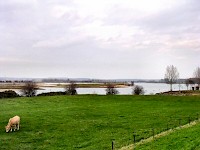Mannaricum (Maurik)
Q1309550Mannaricum: fort in the Roman Rhine limes, modern Maurik in the Netherlands.

The ancient cavalry fort Mannaricium was situated on the southern bank of a branch of the Rhine that no longer exists, and must have been to the northwest of the modern village of Maurik, which still has the same name. The native settlement may have been very old, as it seems to be derived from Maleriacum, a word that can be read as the tax district named after a man with the pre-Roman name Malerus. He must have been a wealthy man when the Roman taxmen arrived.
Stray finds from this area suggest occupation by soldiers after 70 (the year of the Batavian revolt), and perhaps earlier. Probably, the fort was rebuilt in the first quarter of the third century, and evacuated in 275 - like so many other forts along the Lower Rhine. Potsherds and coins suggest a renewed occupation in the fourth century.
Two military units can be identified: around 83, the Second Equestrian Cohort of Thracians (cohors II Thracum equitata) was replaced by the Second Spanish Equestrian Cohort (cohors II Hispanorum equitata). It is interesting to note that the First equestrian cohort of Thracians (cohors I Thracum equitata) was stationed in nearby Rijswijk.
It is probably impossible to excavate the remains of the Roman fort because most artifacts have, until now, been found close to the meandering Rhine.